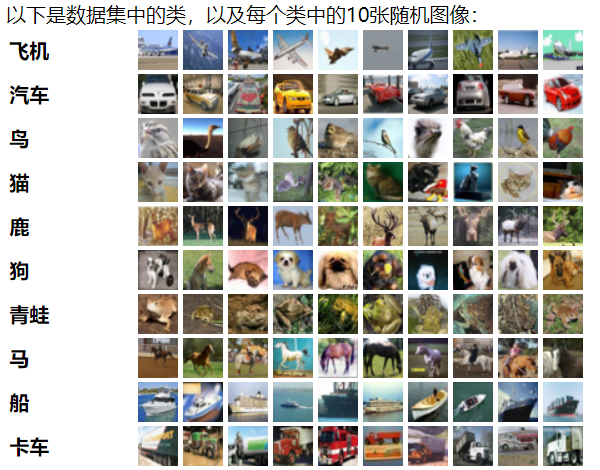这是一个图像分类的比赛CIFAR( CIFAR-10 - Object Recognition in Images )
首先我们需要下载数据文件,地址:
http://www.cs.toronto.edu/~kriz/cifar.html
CIFAR-10数据集包含10个类别的60000个32x32彩色图像,每个类别6000个图像。有50000张训练图像和10000张测试图像。
数据集分为五个训练批次和一个测试批次,每个批次具有10000张图像。测试批次包含每个类别中恰好1000张随机选择的图像。训练批次按随机顺序包含其余图像,但是某些训练批次可能包含比另一类更多的图像。在它们之间,培训批次精确地包含每个班级的5000张图像。
这些类是完全互斥的。汽车和卡车之间没有重叠。“汽车”包括轿车,SUV和类似的东西。“卡车”仅包括大型卡车。都不包括皮卡车。

详细代码:
1.导包
1 import numpy as np 2 3 # 序列化和反序列化 4 import pickle 5 6 from sklearn.preprocessing import OneHotEncoder 7 8 import warnings 9 warnings.filterwarnings('ignore') 10 11 import tensorflow as tf
2.数据加载
1 def unpickle(file): 2
3 with open(file, 'rb') as fo: 4 dict = pickle.load(fo, encoding='ISO-8859-1') 5 return dict 6 7 # def unpickle(file): 8 # import pickle 9 # with open(file, 'rb') as fo: 10 # dict = pickle.load(fo, encoding='bytes') 11 # return dict 12 13 labels = [] 14 X_train = [] 15 for i in range(1,6): 16 data = unpickle('./cifar-10-batches-py/data_batch_%d'%(i)) 17 labels.append(data['labels']) 18 X_train.append(data['data']) 19 20 # 将list类型转换为ndarray 21 y_train = np.array(labels).reshape(-1) 22 X_train = np.array(X_train) 23 24 # reshape 25 X_train = X_train.reshape(-1,3072) 26 27 # 目标值概率 28 one_hot = OneHotEncoder() 29 y_train =one_hot.fit_transform(y_train.reshape(-1,1)).toarray() 30 display(X_train.shape,y_train.shape)
3.构建神经网络
1 X = tf.placeholder(dtype=tf.float32,shape = [None,3072]) 2 y = tf.placeholder(dtype=tf.float32,shape = [None,10]) 3 kp = tf.placeholder(dtype=tf.float32) 4 5 def gen_v(shape): 6 return tf.Variable(tf.truncated_normal(shape = shape)) 7 8 def conv(input_,filter_,b): 9 conv = tf.nn.relu(tf.nn.conv2d(input_,filter_,strides=[1,1,1,1],padding='SAME') + b) 10 return tf.nn.max_pool(conv,[1,3,3,1],[1,2,2,1],'SAME') 11 12 def net_work(input_,kp): 13 14 # 形状改变,4维 15 input_ = tf.reshape(input_,shape = [-1,32,32,3]) 16 # 第一层 17 filter1 = gen_v(shape = [3,3,3,64]) 18 b1 = gen_v(shape = [64]) 19 conv1 = conv(input_,filter1,b1) 20 # 归一化 21 conv1 = tf.layers.batch_normalization(conv1,training=True) 22 23 # 第二层 24 filter2 = gen_v([3,3,64,128]) 25 b2 = gen_v(shape = [128]) 26 conv2 = conv(conv1,filter2,b2) 27 conv2 = tf.layers.batch_normalization(conv2,training=True) 28 29 # 第三层 30 filter3 = gen_v([3,3,128,256]) 31 b3 = gen_v([256]) 32 conv3 = conv(conv2,filter3,b3) 33 conv3 = tf.layers.batch_normalization(conv3,training=True) 34 35 # 第一层全连接层 36 dense = tf.reshape(conv3,shape = [-1,4*4*256]) 37 fc1_w = gen_v(shape = [4*4*256,1024]) 38 fc1_b = gen_v([1024]) 39 fc1 = tf.matmul(dense,fc1_w) + fc1_b 40 fc1 = tf.layers.batch_normalization(fc1,training=True) 41 fc1 = tf.nn.relu(fc1) 42 # fc1.shape = [-1,1024] 43 44 45 # dropout 46 dp = tf.nn.dropout(fc1,keep_prob=kp) 47 48 # 第二层全连接层 49 fc2_w = gen_v(shape = [1024,1024]) 50 fc2_b = gen_v(shape = [1024]) 51 fc2 = tf.nn.relu(tf.layers.batch_normalization(tf.matmul(dp,fc2_w) + fc2_b,training=True)) 52 53 # 输出层 54 out_w = gen_v(shape = [1024,10]) 55 out_b = gen_v(shape = [10]) 56 out = tf.matmul(fc2,out_w) + out_b 57 return out
4.损失函数准确率
1 out = net_work(X,kp) 2 3 loss = tf.reduce_mean(tf.nn.softmax_cross_entropy_with_logits_v2(labels=y,logits=out)) 4 5 # 准确率 6 y_ = tf.nn.softmax(out) 7 8 # equal 相当于 == 9 accuracy = tf.reduce_mean(tf.cast(tf.equal(tf.argmax(y,axis = -1),tf.argmax(y_,axis = 1)),tf.float16)) 10 accuracy
5.最优化
1 opt = tf.train.AdamOptimizer().minimize(loss) 2 opt
6.开启训练
1 epoches = 50000 2 saver = tf.train.Saver() 3 4 index = 0 5 def next_batch(X,y): 6 global index 7 batch_X = X[index*128:(index+1)*128] 8 batch_y = y[index*128:(index+1)*128] 9 index+=1 10 if index == 390: 11 index = 0 12 return batch_X,batch_y 13 14 test = unpickle('./cifar-10-batches-py/test_batch') 15 y_test = test['labels'] 16 y_test = np.array(y_test) 17 X_test = test['data'] 18 y_test = one_hot.transform(y_test.reshape(-1,1)).toarray() 19 y_test[:10] 20 21 with tf.Session() as sess: 22 sess.run(tf.global_variables_initializer()) 23 for i in range(epoches): 24 batch_X,batch_y = next_batch(X_train,y_train) 25 opt_,loss_ = sess.run([opt,loss],feed_dict = {X:batch_X,y:batch_y,kp:0.5}) 26 print('----------------------------',loss_) 27 if i % 100 == 0: 28 score_test = sess.run(accuracy,feed_dict = {X:X_test,y:y_test,kp:1.0}) 29 score_train = sess.run(accuracy,feed_dict = {X:batch_X,y:batch_y,kp:1.0}) 30 print('iter count:%d。mini_batch loss:%0.4f。训练数据上的准确率:%0.4f。测试数据上准确率:%0.4f'% 31 (i+1,loss_,score_train,score_test))
这个准确率只达到了百分之80
如果想提高准确率,还需要进一步优化,调参